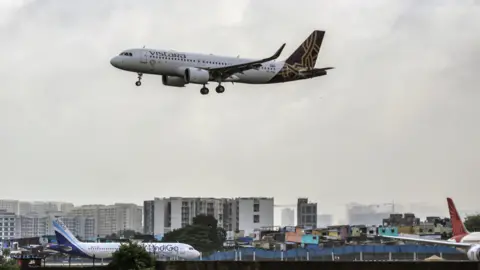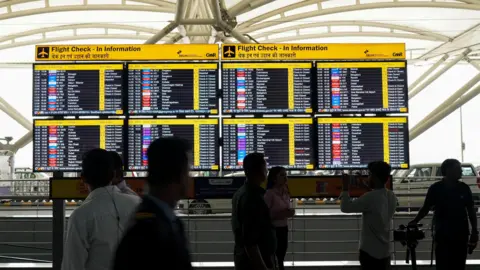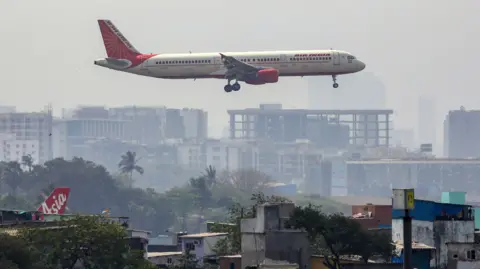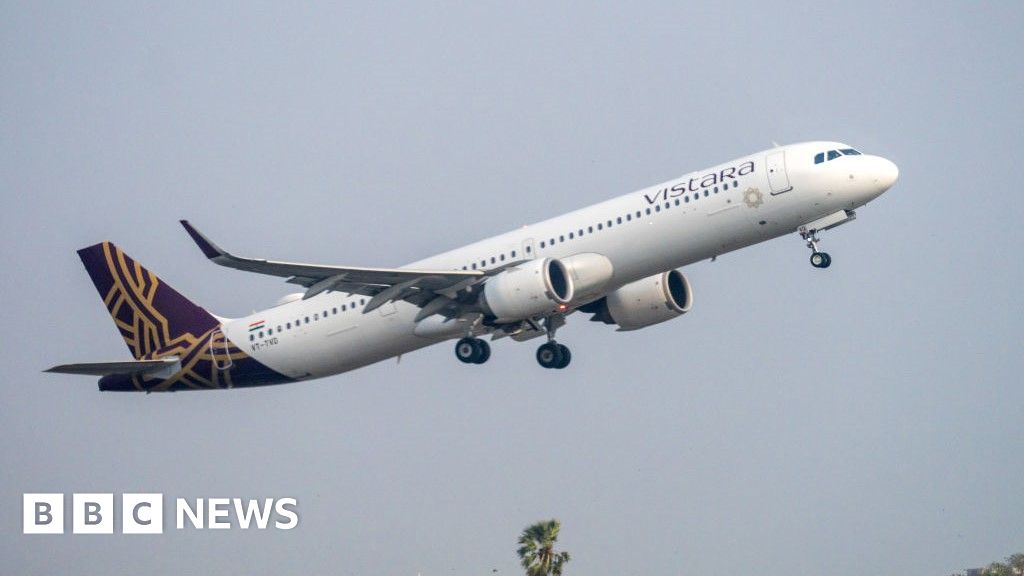 Getty Images
Getty ImagesAfter nine years of existence, Indian full-service airline Vistara will operate its last flight on Monday.
Vistara, a joint venture between Singapore Airlines and Tata Sons, will merge with Tata-owned Air India to form a single entity with a network and broader fleet.
This means that all Vistara operations, including help desk kiosks and ticketing offices, will be transferred and managed by Air India. The process of migrating passengers with existing Vistara bookings and loyalty programs to Air India has been underway for the past few months.
“As part of the merger process, meals, serviceware and other soft elements have been upgraded to incorporate aspects of both Vistara and Air India,” an Air India spokesperson said in an emailed response. said.
Amid concerns that the merger could affect service standards, the Tatas assured that Vistara’s in-flight experience will remain the same.
Vistara, known for its highly rated food, service and cabin quality, has built a loyal customer base, and the decision to discontinue the Vistara brand was criticized by fans, brand experts and aviation analysts. has been.
Aviation analyst Mark Martin said the merger was effectively done to clean Vistara’s books and wipe out losses.
Air India was essentially “duped into buying a loss-making airline” in a desperate bid, he added.
“Mergers are intended to make airlines stronger; they in no way erase or compensate for losses.”
Indeed, Air India and Vistara’s annual losses have more than halved in the past year, and other operating metrics have also improved. However, the merger process so far has been turbulent.
The exercise has been riddled with problems, from a pilot shortage that led to large-scale flight cancellations to Vistara crews being placed on mass sick leave over plans to align pay structures with Air India.
Air India has also repeatedly complained about poor service standards, with videos of broken seats and non-functioning in-flight entertainment systems going viral.
 Getty Images
Getty ImagesTatas has announced a $400m (£308m) program to upgrade and refurbish the interiors and brand new liveries of older aircraft. It also ordered hundreds of new Airbus and Boeing planes worth billions of dollars to augment its product offering.
But Martin says this “turnaround” is still incomplete and fraught with problems. Mergers only complicate matters.
Experts say the merger will also cause dissonance from a branding perspective.
Brand strategy specialist Harish Bijoor told the BBC he was “emotional” that a product as great as Vistara, which had developed the “gold standard of Indian aviation”, would be grounded.
“This is a huge loss for the industry,” Bijoor said, adding that for its mother brand Air India, given that Vistara is much smaller, the high standards set by Vistara could simply be “copy and paste.” It would be a monumental task to exceed that goal, he added. An airline that is being swallowed up by a much larger airline.
Bijoor believes that a better strategy would have been to run Air India independently for five years, with a focus on improving service standards while maintaining Vistara as a separate brand bearing the Air India name. It suggests that it is.
“That would have given Air India time and opportunity to revise the mother brand and bring it to the level of Vistara while retaining its uniqueness,” he added.
Beyond branding, the combined entity will face a number of operational challenges.
 shutter stock
shutter stockAjay Otani, editor of the airline portal site Live from a Lounge, said, “When a customer arrives at the airport expecting a Vistara flight, they simply find the Air India brand, and communication is difficult in the early stages.” It’s going to be a big challenge.” “Air India needs to maintain clear communication for several weeks.”
Another important challenge, he points out, is cultural. Vistara’s nimble employees may have a hard time adapting to Air India’s complex bureaucracy and systems.
But the biggest challenge for the combined airlines will be providing customers with a uniform flying experience.
This is “the merging of two airlines with very different service formats into one airline. It will be a hodgepodge of service formats, cabin formats, branding and customer experiences. It involves learning and unlearning. “However, such processes are rarely collaborative with airlines and rarely effective,” Martin said.
Still, many believe Vistara should have left now or in the next few years.
As a heritage brand like Air India has strong global recognition and has ‘India’ etched in its identity, smaller and more upscale subsidiaries will overshadow its revival process. That would not have been allowed.
Financially, it makes little sense for the Tatas to pit two loss-making companies against each other.
The combined strength of Vistara and Air India could also put Tatas in a better position to compete with market leader IndiGo.
The combined Air India Group (including Air India Express, which completed its merger with the former Air Asia India in October) will have “nearly 300 aircraft, an expanded network and a stronger workforce”. With power, we will be bigger and better,” Air India said. This was announced by an Indian spokesperson.
“Completing the merger means Air India will grow overnight and both teams will start working together instead of competing. There is no perfect day for a merger. Somewhere you will draw the line. There was a need,” Otany said.
But for many Vistara supporters, Vistara’s demise leaves a vacuum for a premium full-service airline in India’s skies, the third such gap after the collapses of Kingfisher Airlines and Jet Airways.
It is too early to tell whether Air India, which often ranks last in airline surveys, will be able to successfully fill the void.




